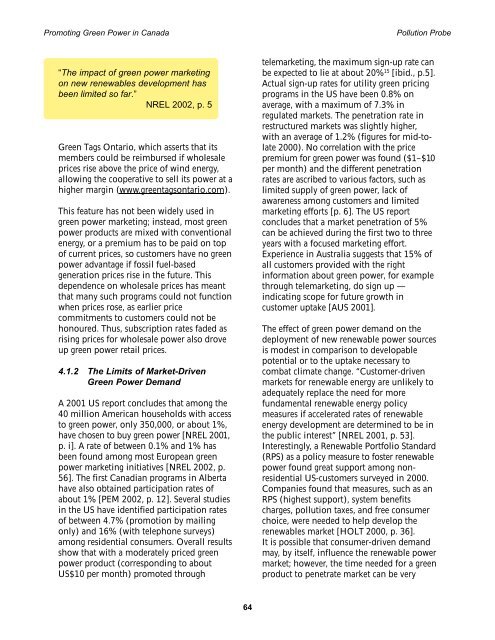Promoting Green Power in Canada - Centre for Human Settlements
Promoting Green Power in Canada - Centre for Human Settlements
Promoting Green Power in Canada - Centre for Human Settlements
- No tags were found...
You also want an ePaper? Increase the reach of your titles
YUMPU automatically turns print PDFs into web optimized ePapers that Google loves.
<strong>Promot<strong>in</strong>g</strong> <strong>Green</strong> <strong>Power</strong> <strong>in</strong> <strong>Canada</strong> Pollution Probe“The impact of green power market<strong>in</strong>gon new renewables development hasbeen limited so far.”NREL 2002, p. 5<strong>Green</strong> Tags Ontario, which asserts that itsmembers could be reimbursed if wholesaleprices rise above the price of w<strong>in</strong>d energy,allow<strong>in</strong>g the cooperative to sell its power at ahigher marg<strong>in</strong> (www.greentagsontario.com).This feature has not been widely used <strong>in</strong>green power market<strong>in</strong>g; <strong>in</strong>stead, most greenpower products are mixed with conventionalenergy, or a premium has to be paid on topof current prices, so customers have no greenpower advantage if fossil fuel-basedgeneration prices rise <strong>in</strong> the future. Thisdependence on wholesale prices has meantthat many such programs could not functionwhen prices rose, as earlier pricecommitments to customers could not behonoured. Thus, subscription rates faded asris<strong>in</strong>g prices <strong>for</strong> wholesale power also droveup green power retail prices.4.1.2 The Limits of Market-Driven<strong>Green</strong> <strong>Power</strong> DemandA 2001 US report concludes that among the40 million American households with accessto green power, only 350,000, or about 1%,have chosen to buy green power [NREL 2001,p. i]. A rate of between 0.1% and 1% hasbeen found among most European greenpower market<strong>in</strong>g <strong>in</strong>itiatives [NREL 2002, p.56]. The first Canadian programs <strong>in</strong> Albertahave also obta<strong>in</strong>ed participation rates ofabout 1% [PEM 2002, p. 12]. Several studies<strong>in</strong> the US have identified participation ratesof between 4.7% (promotion by mail<strong>in</strong>gonly) and 16% (with telephone surveys)among residential consumers. Overall resultsshow that with a moderately priced greenpower product (correspond<strong>in</strong>g to aboutUS$10 per month) promoted throughtelemarket<strong>in</strong>g, the maximum sign-up rate canbe expected to lie at about 20% 15 [ibid., p.5].Actual sign-up rates <strong>for</strong> utility green pric<strong>in</strong>gprograms <strong>in</strong> the US have been 0.8% onaverage, with a maximum of 7.3% <strong>in</strong>regulated markets. The penetration rate <strong>in</strong>restructured markets was slightly higher,with an average of 1.2% (figures <strong>for</strong> mid-tolate2000). No correlation with the pricepremium <strong>for</strong> green power was found ($1–$10per month) and the different penetrationrates are ascribed to various factors, such aslimited supply of green power, lack ofawareness among customers and limitedmarket<strong>in</strong>g ef<strong>for</strong>ts [p. 6]. The US reportconcludes that a market penetration of 5%can be achieved dur<strong>in</strong>g the first two to threeyears with a focused market<strong>in</strong>g ef<strong>for</strong>t.Experience <strong>in</strong> Australia suggests that 15% ofall customers provided with the right<strong>in</strong><strong>for</strong>mation about green power, <strong>for</strong> examplethrough telemarket<strong>in</strong>g, do sign up —<strong>in</strong>dicat<strong>in</strong>g scope <strong>for</strong> future growth <strong>in</strong>customer uptake [AUS 2001].The effect of green power demand on thedeployment of new renewable power sourcesis modest <strong>in</strong> comparison to developablepotential or to the uptake necessary tocombat climate change. “Customer-drivenmarkets <strong>for</strong> renewable energy are unlikely toadequately replace the need <strong>for</strong> morefundamental renewable energy policymeasures if accelerated rates of renewableenergy development are determ<strong>in</strong>ed to be <strong>in</strong>the public <strong>in</strong>terest” [NREL 2001, p. 53].Interest<strong>in</strong>gly, a Renewable Portfolio Standard(RPS) as a policy measure to foster renewablepower found great support among nonresidentialUS-customers surveyed <strong>in</strong> 2000.Companies found that measures, such as anRPS (highest support), system benefitscharges, pollution taxes, and free consumerchoice, were needed to help develop therenewables market [HOLT 2000, p. 36].It is possible that consumer-driven demandmay, by itself, <strong>in</strong>fluence the renewable powermarket; however, the time needed <strong>for</strong> a greenproduct to penetrate market can be very64
















